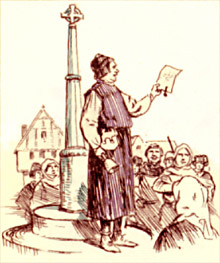 |
| Charles II of Naples and Mary of Hungary, Queen of Naples |
The first thought that struck me, upon reading that statement, was that most men apparently got married between the ages of twenty-six and thirty-three. While that doesn't seem like such a stretch in the modern world, most of us think of families getting started much earlier back then (in 1960, the average American man was getting married at 22 and his partner was 20). It's important to remember, though, that men needed to be able to provide a home for their families. Remember that post about the implications of there being more men than women? Ladies were a valuable resource. Guys needed to establish themselves in the world before parents would consent to the match.
One structure limiting this economic establishment was the apprenticeship contract. Learning a craft under a master was a time consuming and laborious proposition. While the details of the contracts may have varied, based on master or profession, the majority prohibited marriage until the end of the term agreed. Furthermore, apprentices tended to live in the master's home and make little to nothing in terms of wages. It was only upon reaching the status of journeyman that a craftsman could afford to think of the fairer sex, and even then he couldn't open his own establishment (in guild controlled areas) until achieving the rank of master.
While the Church held major sway regarding sexual practice, it's difficult to imagine the average woman holding off until sixteen, but impossible to imagine the average man waiting until after his twenty-sixth birthday. Surprisingly, the Church's answer to men's quandary (at least in France) was hookers. "... the medieval Church saw it as the only concession that could be admitted to the tyranny of sex." (pg 90). Apparently, the church actually ran the bawdy houses, in accord with the local authorities, allowing men to make donations to the church in penance for the sins they committed within. This is not to say that all prostitutes were Church sponsored, there were streetwalkers and ladies who worked the bathhouses as well. The point is, to maintain this cultural norm, folks kinda fudged another one.
Even today, people have difficulty understanding May-September romances. Either they think that the woman is taking advantage of the rich older man in his dotage or that the man is trying to prove his virility (it's still very rare for the woman to be much older). Imagine then, how things were long ago, when medicine was not as advanced and the years wore harder on the human frame (think dentistry). Additionally, as we have seen, these marriages were less likely to be love stories than they were best available options. Small wonder that adultery was winked at by society. Who doesn't feel for Lancelot and Guinevere? Arthur may have been a fine king, but we all get it.
Using this information in a fictional setting can be a bit dicey. As I've stated before, it's important to have an idea about the social influences which lead to certain practices so you can figure out how to include what you want in your own. If you are fascinated by the age differential, then by all means, go ahead. The concept of young men needing to prove themselves before being wed makes sense in all kinds of worlds, but maybe not if the genders are equal. How do people view adultery? Do they joke about it, like Chaucer does in The Miller's Tale? Will your army provide their own prostitutes for the march, or do they discourage such camp followers, like Joan of Arc did? Have fun with your world, but be alert to how small changes may have a ripple effect across the entire social dynamic.
Modern Marriage - http://www.theatlantic.com/sexes/archive/2013/03/getting-married-later-is-great-for-college-educated-women/274040/




